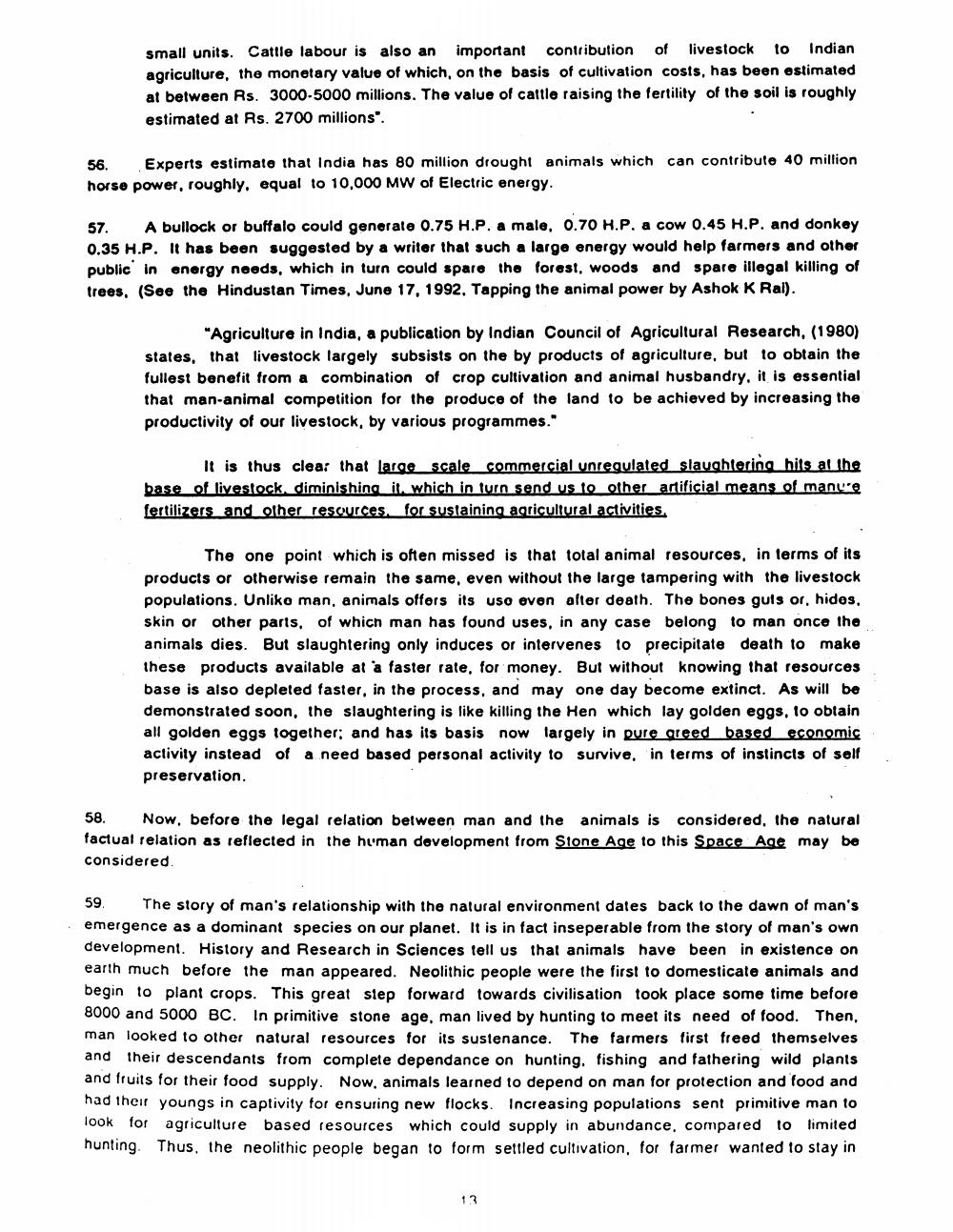________________
small units. Cattle labour is also an important contribution of livestock to Indian agriculture, the monetary value of which, on the basis of cultivation costs, has been estimated at between Rs. 3000-5000 millions. The value of cattle raising the fertility of the soil is roughly estimated at Rs. 2700 millions'.
56. Experts estimate that India has 80 million drought animals which can contribute 40 million horse power, roughly. equal to 10,000 MW of Electric energy.
57. A bullock or buffalo could generale 0.75 H.P. a male, 0.70 H.P. a cow 0.45 H.P. and donkey 0.35 H.P. It has been suggested by a writer that such a large energy would help farmers and other public in energy noods, which in turn could spare the forest, woods and spare illegal killing of trees. (See the Hindustan Times, June 17, 1992, Tapping the animal power by Ashok K Ral).
"Agriculture in India, a publication by Indian Council of Agricultural Research, (1980) states, that livestock largely subsists on the by products of agriculture, but to obtain the fullest benefit from a combination of crop cultivation and animal husbandry, it is essential that man-animal competition for the produce of the land to be achieved by increasing the productivity of our livestock, by various programmes."
It is thus clear that large scale commercial unregulated slaughtering hits at the base of livestock diminishing ilk which in turn send us to other artificial means of many'e fertilizers and other resources for sustaining agricultural activities.
The one point which is often missed is that total animal resources, in terms of its products or otherwise remain the same, even without the large tampering with the livestock populations. Unliko man, animals offers its uso even after death. The bones quis or, hidos, skin or other parts, of which man has found uses, in any case belong to man once the animals dies. But slaughtering only induces or intervenes to precipitate death to make these products available at a faster rate, for money. But without knowing that resources base is also depleted faster, in the process, and may one day become extinct. As will be demonstrated soon, the slaughtering is like killing the Hen which lay golden eggs, to obtain all golden eggs together, and has its basis now largely in pure areed based economis activity instead of a need based personal activity to survive, in terms of instincts of self preservation.
58. Now, before the legal relation between man and the animals is considered, the natural factual relation as reflected in the human development from Stone Age to this Space Age may be considered
59. The story of man's relationship with the natural environment dates back to the dawn of man's emergence as a dominant species on our planet. It is in fact inseperable from the story of man's own development. History and Research in Sciences tell us that animals have been in existence on earth much before the man appeared. Neolithic people were the first to domesticate animals and begin to plant crops. This great step forward towards civilisation took place some time before 8000 and 5000 BC. In primitive stone age, man lived by hunting to meet its need of food. Then, man looked to other natural resources for its sustenance. The farmers first freed themselves and their descendants from complete dependance on hunting, fishing and fathering wild plants and fruits for their food supply. Now, animals learned to depend on man for protection and food and had their youngs in captivity for ensuring new flocks. Increasing populations sent primitive man to look for agriculture based resources which could supply in abundance, compared to limited hunting. Thus, the neolithic people began to form settled cultivation, for farmer wanted to stay in
13




